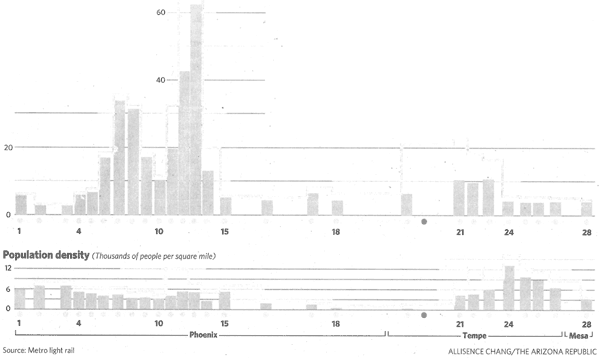Commuter Rail Numbers Don't Even Work With the Supporters' Numbers
From the AZ Republic, which just can't stop itself from shamelessly cheerleading any effort to spend billions on rail in Phoenix (perhaps the world's worst candidate for rail transit given its density and distribution of businesses).
Enough people would board a train in the Valley's suburbs that a future commuter-rail system would be as popular as some of the busiest lines in the West, new studies have found.
Well, that's a low bar.
A trio of yearlong rail studies, in nearly final form, indicates commuter rail could carry almost 18,000 passengers a day by 2030. Planners at the Maricopa Association of Governments
say, based on the findings, they favor a 105-mile, X-shaped system that could feature 33 stations and cost roughly $1.5 billion. That's a little more than the Valley's 20-mile, light-rail starter line.
If this was presented to me as a business opportunity, I would have had them stop right there. Even before inevitable cost overruns and over-confidence in ridership, even with the supporters' numbers, they want $1.5 billion to carry 18,000 people a day. That is a capital cost of $83,000+ per daily rider, beating the old record of Phoenix light rail which cost around $75,000 per daily rider.
Planners assume the trains will recoup about 40 percent of their expenses, based on the national average for similar service. The average fare would be about $6 to $7, Wallace said, although no detailed study has gone into fares. Generally, rates would go up the farther the trip.
Can you imagine any other investor in the world other than the government making an investment knowing that in the best case of its strongest supporters revenues will only cover 40% of costs? And why should the rest of us subsidize folks who live in outlying areas to commute? They moved to those areas in large part because housing was cheap and cost of living was low, with the knowlege they had a long commute. So those of us with the forsight to live close to work have to subsidize them? This is a really valuable service for them but they can't even pay half the cost?
Further, lets look at those cost estimates. If we get 18,000 a day on weekdays and a third that on weekends, that yields 5 million round trips. Given an 8% interest rate over 30 years, the capital charge is $134 million a year before overruns. That means the fare would have to be $27 round trip or $13.50 one way just to cover the capital cost alone, without even considering operating costs.
This means their figures are nuts. $6-$7 one-way fares barely covers 40% of the capital costs, much less the operating expenses. We are talking about an offering that is deep in the red. $13 round trip at 5,000,000 round trips equals $65,000,000 of revenue. That means that taxpayers will have to foot the bill for all the operating costs ($30 million? $60 million) and at least $69 million of capital charges. It is not unfair to assume that this would punch a minimum $100 million hole each year in the government's budget that we will have to make up with taxes.
Update: Gotta achnowlege this bit of sanity in the AZ Republic comments from "astonished"
Light rail is such a boondoggle. It's expensive to build and always runs at a loss. It is very hard to change the routes to respond to ridership needs. It's a vanity project for hip liberals.
If public transportation is a goal, then get some buses going. Buses are flexible, cost effective, cheap to run and maintain, and if ridership changes, you just change the routes and schedules.

